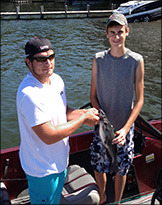Welcome to the Arkansas Fishing Roundup. If you have a fishing tale or picture to share with us, please do. You can contact us at info@sportinglifearkansas.com. We look forward to hearing about your fishing exploits and sharing them with others.
Central Arkansas Kayak Anglers Host Bass Tournament
Our roving Arkansas outdoors reporter, Tommy Jones tells us this:
I have fished in bass tournaments before, but never one quite like this.
On Saturday July 20th, I fished in my first tournament with the Central Arkansas Kayak Anglers. This is a group of fisherman who are committed to pursuing the waters of Arkansas without the assistance of a motor!
For the July 20th, tournament we fished Lake Maumelle, which is the Arkansas equivalent to the Dead Sea. The easy access of Maumelle makes for high fishing pressure and typically light stringers. But, 15 boats in the tournament all launched with high hopes nonetheless.
We didn’t set any records with fishing, but everyone had a great time. There was certainly competition, but unlike other tournaments I have been in, this was more about enjoying the outdoors and building relationships than it was trying to impress sponsors.
I was really impressed. The entire time people were friendly and welcoming. I can’t wait for the next tournament.
If you want to enjoy the lakes and rivers of Arkansas, a Kayak is a relatively inexpensive way to make the move. Our next tournament is on Lake Conway – and we would love to have you join us!
Fishermen hit the daily double on Lake Hamilton, Lake Catherine
 HOT SPRINGS – Fishermen hit the daily double on Lake Hamilton and Lake Catherine by landing prize-winning fish in the 2013 $60,000 Hot Springs Fishing Challenge.
HOT SPRINGS – Fishermen hit the daily double on Lake Hamilton and Lake Catherine by landing prize-winning fish in the 2013 $60,000 Hot Springs Fishing Challenge.
Rookie fisherman Chase Allison, 16, of Hot Springs and Seth McVay of Poyen brought in fish Nos. 9 and 10 in the fishing contest.
Allison, in his first summer of learning how to fish, caught a $1,000 catfish on Lake Hamilton about 10 a.m. Saturday. He was fishing with a friend, Taylor Culbreath, from a boat around a dock across from the Andrew Hulsey Fish Hatchery. Allison was fishing for bass using a Chatter Bait when he thought he had snagged his friend’s line. To his surprise, he reeled in a tagged catfish.
Later on the same day, McVay hauled in a $500 largemouth bass on Lake Catherine.
It was the daily double in Hot Springs with a tagged fish caught on Lake Hamilton in the morning and another caught in the afternoon on Lake Catherine.
Fishing with some friends and enjoying a beautiful day on the lake, he caught the money fish at Spencer’s Point near Munro’s shoe plant. McVay used a Square Bill crank bait to bring home the money.
Ten fish have now been caught worth $8,500 in prize money in the Fishing Challenge.
With only a few days remaining in the 2013 $60,000 Hot Springs Fishing Challenge, Big Al II remains on the lam.
“The $10,000 grand prize fish remains uncaptured,” said Steve Arrison, CEO of Visit Hot Springs, the Challenge’s sponsor. “It looks like the big guy may elude all of our expert fishing pursuers again. Big Al I wasn’t caught in the 2012 Challenge, either.”
“It’s like this wily specimen is thumbing its nose at a whole lot of people who have been furiously trying to bring him in,” Arrison continued. “I can almost hear him saying, ‘They couldn’t catch any of the gangsters back in the ‘20s and ‘30s, and they can’t catch me.’ So I’m going to turn fink on Big Al and tell his pursuers how to land him and haul in $10,000 before the July 31 deadline when the Challenge ends.”
“Okay, here it is: Big Al II is a bluegill with tag number 254 and he’s somewhere in Lake Hamilton. That should narrow the search area. “And to even the odds still more, we asked Steve ‘Wildman’ Wilson of the Arkansas Game and Fish Commission for some tips on how to catch a fugitive bluegill. Here’s what he told us.”
- Bluegill usually congregate around vegetation and sunken trees of shallow backwater bays. In midsummer they may move to water that is a little deeper.
- Fish for them using worms, crickets, mealworms, small jigs, spinners, and poppers.
- Use live bait (crickets, worms, mealworms) under a bobber. The smaller the bobber, the better to detect bites.
- Use any kind of rod and reel or even a cane pole, light line is best. Use long-shanked No. 8 hooks. They’re small enough to fit in the bluegill’s mouth, but the long shank makes it easy to remove the hook.
- Don’t waste time watching your bobber. If a bluegill is there, it will hit in about 30 seconds. Move until you find the fish.
- If you see an overhanging limb with webworms or mayflies crawling on it, fish underneath and get ready.
- Morning and evening are the best times to fish.
The contest is open to anyone with a valid Arkansas fishing license. Employees of the Hot Springs Advertising and Promotion Commission, the Arkansas Game and Fish Commission at the Andrew H. Hulsey Fish Hatchery, and their immediate family members, and/or those living in the same household of each are ineligible to win a cash prize.
The tagged fish that remain are:
- Big Al $10,000
- 2 fish $5,000
- 22 fish $1,000
- 17 fish $500
This year’s Challenge runs through July 31. The Second Hot Springs Fishing Challenge, which began May 1, provides anglers the opportunity to catch tagged fish that can be redeemed for cash prizes.
For additional information call Steve Arrison at 501-321-2027.
Courtesy Arkansas Game and Fish Commission
Striped bass program offers big fish and big fun to Arkansas anglers
HOT SPRINGS – Arkansas anglers looking for a deep-sea fishing thrill don’t need to travel far to tangle with a trophy. Thanks to the Arkansas Game and Fish Commission’s striped bass program, stripers regularly topping 20 pounds swim in many Arkansas lakes to test angler’s equipment and raise their heart rate.
Striped bass are naturally found in salt water, but migrate into freshwater rivers and streams to reproduce. They also can adapt to life in in landlocked freshwater lakes if the conditions are right.
Stripers can grow to tremendous sizes in fresh water. Arkansas’s state record striped bass weighed 64 lbs. 8 oz. and was caught below Beaver Lake in 2000. But they can’t reproduce naturally in Arkansas’s reservoirs.
“With the exception of a few striped bass on the Arkansas River, every striped bass in Arkansas is a product of our hatchery system,” said Don Brader, AGFC assistant fisheries chief. “We also produce a hybrid striper by crossing striped bass with native white bass.”
The process for producing striped bass and hybrid striped bass is a labor of love, one the AGFC has been conducting annually since the 1970s.
AGFC fisheries biologists and technicians spend between 1,000 and 1,500 man hours each year to offer anglers this added opportunity.
In mid-April, netting crews intercept stripers at night as they make their annual spawning runs upstream.
“We check the nets every few hours, collect male and female stripers, and carefully transport them to (Andrew) Hulsey Hatchery near Hot Springs,” Brader said.
Once at the hatchery, a weeks-long vigil begins.
“AGFC staff watch the fish around the clock, checking the stripers to see if they’re ready,” Brader said. “Once a female striper begins to ovulate, we have less than half an hour to collect those eggs.”
Hatchery technicians massage eggs from female stripers and milt from male stripers (or white bass, if hybrids are being produced) and mix them together in sterile containers to ensure fertilization.
“The eggs are placed in glass containers with constantly flowing water to keep them aerated,” Brader said. “The water has to stay 64- to 66 degrees, or the eggs may not develop.”
The eggs hatch in about 48 hours and the fry are moved to holding tanks for about four days. Once fully developed, they are moved into hatchery ponds to grow.
By July the fry will be about 2 inches long and are ready to be stocked.
Much like Arkansas’s famed trout fisheries, lakes with stripers have gained a devoted following among anglers interested in battling big fish. According to the U.S. Fish and Wildlife Service about 63,000 anglers fished for white bass, striped bass and hybrids in 2011.
“Many anglers who catch the occasional striper when fishing for other species often want to learn more about how to catch them,” said Mark Oliver, AGFC chief of fisheries. “One of the best resources a person can use is a local striper fishing club or guide that operates on our striper lakes. These people stay on top of the fish year-round and can definitely cut down the learning curve for newcomers.”
Some anglers worry that striped bass eat black bass and other game fish, but their diet is almost entirely shad.
“There have been several studies done on the eating habits of stripers in reservoirs,” said Brett Hobbs, AGFC fisheries management biologist in Hot Springs. “All of these studies indicate striped bass are extremely unlikely to eat black bass.”
Hobbs explains that adult striped bass stay in the cool open water of the lake, not around shoreline cover like black bass.
“A Lake Hamilton study showed shad made up 92 percent of prey items found in sampled striped bass,” said Hobbs. “And that was during a winter drawdown, when bass, crappie and other game fish were forced into deeper open water where stripers stay.”
Because of this high dependence on shad, waters where stripers are stocked are scrutinized each year to ensure that the food chain remains balanced.
“Stripers help control the amount of large gizzard shad in a lake that have grown too large for other game fish to prey upon.” Brader said. “But if we see the shad populations decline, we immediately cut down on the number of stripers stocked in those waters. Because they don’t reproduce naturally, we can directly control the population to keep our fisheries healthy and keep this opportunity alive for Arkansas anglers.”
Courtesy Arkansas Game and Fish Commission












